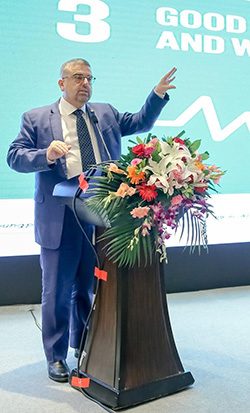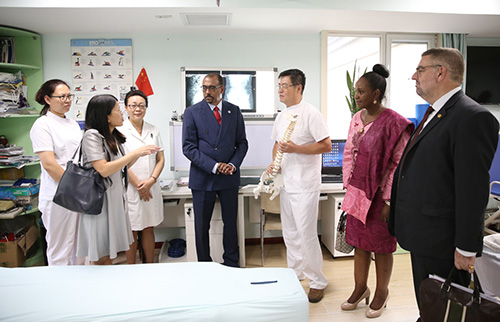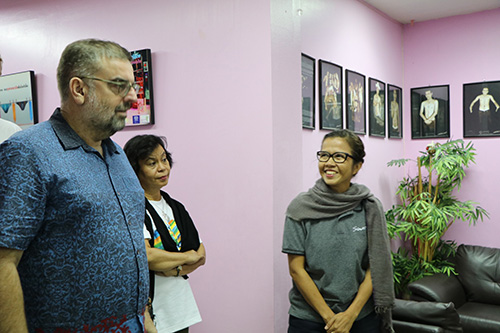Eamonn Murphy took on the role of UNAIDS Director of the Regional Support Team (RST) for Asia and the Pacific in July 2017. The RST is an integrated partnership between the countries in the region and the Bangkok-based UNAIDS office, focused on achieving the goals of the 2016 United Nations Political Declaration on Ending AIDS.

Eamonn Murphy, UNAIDS Director of the Regional Support Team for Asia and the Pacific, gives a presentation at the Belt and Road High-Level Meeting for Health Cooperation in Beijing, China, during a session on Young Generation Leaders in Global Health.TREAT Asia Report: What are the priority issues for the HIV/AIDS response in the Asia Pacific region? How does/will the UNAIDS Regional Support Team for Asia and the Pacific address them?
Eamonn Murphy: Despite improvements in treatment, in the last six years the region has seen only a 13% decline in new infections, compared to a 34% decrease in the decade before. Globally treatment is reaching more than 50% of people living with HIV, but in the Asia-Pacific region the treatment rate is under 50%. We’re falling behind Eastern and Southern Africa, where there have been much stronger advances.
Seven countries in our region have seen a recent rise in new infections, but in different populations and at different rates. We have to be vigilant in responding to what the data are telling us. The challenge is to address the complacency that seems to have set in and to help countries renew and target their HIV response effectively.
The epidemic is shifting. In the Philippines, there has been a 140% increase in new HIV infections from 2010 to 2016. In India there are new outbreaks in states that didn’t have significant HIV before. There are rising epidemics among young urban men who have sex with men in Thailand, the Philippines, Vietnam, and Myanmar. In every country in the region we have to look at where and in which populations the epidemic is occurring, and what is the right mix of interventions to address it. We also need to focus much more intensively on the countries experiencing the bulk of the epidemic.
Community mobilization is essential. Our data is helping countries get granular information about where the infections are occurring. For example, Malaysia has launched a data hub, which is working with the one here at UNAIDS RST in Bangkok to get more accurate data on the state level.
If you’re afraid of losing your job if your employer finds out your HIV status, you’re going to delay going for treatment.TREAT Asia Report: The Political Declaration adopted by UNAIDS in 2016 includes a new focus on women, adolescent girls, young people, and gender equality. What new activities is your team coordinating to achieve UNAIDS’ targets in these areas?
Murphy: A third of people living with HIV are women, so in order to achieve the UNAIDS Fast-Track targets we need to reduce HIV infections to less than half a million by 2020. That means a 75% reduction among women and girls over the next five years. We’re working with partners including the WHO and UNICEF on technical support for countries to help achieve these goals. We have been working closely with UN Women, including their cities and women’s campaign, and we are engaging with UNICEF and the United Nations Population Fund on youth issues concerning HIV. We’re also working with countries on changing policies related to testing in young people. In the Philippines, for instance, the age of sexual consent is 12, but a 16-year-old cannot get an HIV test without permission of the parent.

Eamonn Murphy visits the Yuetan Community Health Centre in Beijing, China. At center (wearing blue suit) is Michel Sidibé, UNAIDS Executive Director.
We’ve started a new campaign called #Live2LUV to reach young people, particularly from key populations where there’s been an increase in new infections. It’s being led by Pia Alonzo Wurtzbach, Miss Universe 2015, the UNAIDS Goodwill Ambassador for Asia and the Pacific. She is doing an amazing job of leveraging her social media accounts, on which she has more than 5 million followers, to raise awareness about HIV.
Thailand is the first country in our region to achieve the elimination of mother-to-child transmission, and some other countries are poised do so as well.
TREAT Asia Report: The Political Declaration recognizes that human rights violations remain a major obstacle in the response to HIV. In a region that has seen significant recent violations, how does your team work with governments, civil society, and development partners to address human rights issues?
In every country in the region we have to look at where and in which populations the epidemic is occurring.Murphy: One of the biggest barriers to treatment access is stigma and discrimination. If you’re afraid of losing your job if your employer finds out your HIV status, and you’re feeling fairly well, you’re going to delay going for treatment, even if you know you’re living with HIV. Far too many people—even in Thailand, which has high coverage and a test-and-treat model—come in for treatment at a late stage of illness, with a CD4 count below 200. This not only jeopardizes their own health but increases HIV transmission. We work with the International Labor Organization against mandatory HIV testing of workers by their employers and loss of employment if they test positive.
Stigma and discrimination against key populations also impede prevention efforts. If you are afraid of arrest or harassment by government officials, including police and healthcare workers, you’re not going to access government services. Stigma can also extend to the civil society groups that are providing services—outreach workers are sometimes harassed as well.
An individual country approach is needed to address human rights issues. For example, Quezon City in the Philippines has a program in which city health workers do outreach in places where people are meeting and engaging. That changes the dynamic, if people see support from their government and not discrimination. Thailand has a training program to address stigma and discrimination among healthcare workers, and now the program is being adapted to other countries, including Vietnam, Lao PDR, and Myanmar.
Legal reform is also essential to the HIV response. For example, a recent decision of the Supreme Court of India, if upheld, will have a substantial positive impact on the right to privacy, including around sexual orientation. If the Supreme Court ruling holds it will overrule a section in the penal code—which a number of countries in our region also have—that makes “unnatural” sex illegal. That would be a major step forward, because people would have less fear about identifying their risk behaviors and accessing support.

Mr. Murphy meets with Surang Janyam (right), Director of the Service Workers In Group (SWING) Foundation, at SWING's offices in Bangkok, Thailand.
TREAT Asia Report: How would proposed reductions in U.S. funding for the global AIDS response affect efforts to reduce the HIV burden in the Asia-Pacific?
Murphy: International funding across our region has dropped by about 25% over the last five years. The share of domestic investment has increased 75% over that period. But there’s still about a 40% shortfall in what’s needed to achieve the UNAIDS Fast-Track targets by 2020.
Across the region, about 34% of prevention spending, which has a high dependence on international support, is on key populations. But much of the rest of the spending is not being used where it is most needed. Some countries have a treat-everyone-the-same approach across the regions, and that means some resources are wasted. And increasingly countries will move to middle-income country status, so that will affect international support from a range of donors. We need to help countries increase domestic investment, and to allocate more money to prevention for key populations, in the right places.
TREAT Asia Report: What are key lessons you learned from your experience as UNAIDS Country Director in both Vietnam and Myanmar that are informing your role as Director of the Regional Support Team?
Murphy: My experiences have helped me understand the challenges of HIV at the community and country level. Vietnam and Myanmar have different government systems and very different epidemics—and so require different responses. I’ve learned that if we’re going to seriously support the Fast-Track agenda, there needs to be less focus on regional discussions and more action at the country level. And I build on the work of my predecessors Steve Kraus and Prasada Rao, who also had strong experience working at the country level.
TREAT Asia Report: As we continue to move towards increased national-level funding and domestic financing in this region, how does your regional team bring impactful support to countries and their HIV programs?
An individual country approach is needed to address human rights issues.Murphy: We are supporting evidence-based advocacy surrounding the financing. That’s where granular data analysis comes into play. We have to get past the national data and help countries understand in a much more nuanced way what’s going on with their epidemics, so they can advocate effectively.
Resources for prevention efforts among key populations have historically come from external donors, and that’s a worry. We have to get sustainability for the response. A case management approach is needed for prevention, and to make sure people move from testing into the different levels of treatment and adherence. With increased urbanization, an approach where we work at the city level with municipal health departments and community groups is needed for resource mobilization.
Universal health coverage is critical, and integrating and mainstreaming HIV prevention and treatment is part of that. We are trying to help countries implement a health promotion approach, and to put resources into technology transfer and capacity building. The insurance systems that go with universal health coverage are vital. Vietnam, for example, has used the insurance system to help people with HIV maintain access to treatment.